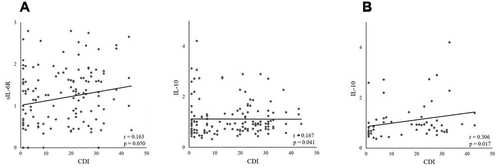Figures & data
Figure 1 Simplified schematic diagram of crucial immune cells and mediators involved in inflammatory response system (IRS) and compensatory immune response system (CIRS) pathways in major depression. IRS pathway includes: 1. activated M1 macrophages releasing interleukin (IL)-1β, IL-6 associated with soluble IL-6 receptor (sIL-6R), tumor necrosis factor α (TNF-α); 2. activated T helper 1 cells (Th1) releasing IFN-γ; and 3. activated Th17 cells releasing IL-17. CIRS pathway consists of: 1. activated M2 macrophages releasing IL-10; 2. activated Th2 cells releasing IL-4; and 3. activated T regulatory (Treg) cells releasing IL-10. Other markers involved in CIRS pathway include soluble cytokine receptors (sIL-2R, sTNF-R1, sTNF-R2) and soluble IL-1 receptor antagonist (sIL-1RA). Macrophages and T-lymphocytes interplay with each other and can drive their polarization. More specifically, Th cells (Th1, Th2, Th17) drive the polarization of M0 to M1 and/or M2 macrophages. Moreover, Th1 cells bi-directionally interact with M1, while Th2 and Treg cells with M2.

Table 1 Evaluated Cytokines, Soluble Cytokine Receptors, IRS and CIRS-Related Profiles, and IRS vs CIRS Activity Ratios

